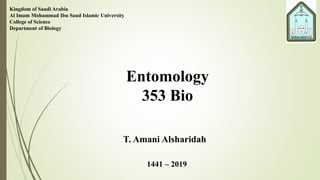Insect Nervous System
•Download as PPTX, PDF•
5 likes•4,059 views
Entomology
Report
Share
Report
Share

Recommended
Recommended
More Related Content
What's hot
What's hot (20)
Metamorphosis, Diapause and its types; immature stages of insects

Metamorphosis, Diapause and its types; immature stages of insects
Diapause and cold hardiness in insects – biochemical aspects

Diapause and cold hardiness in insects – biochemical aspects
Similar to Insect Nervous System
Similar to Insect Nervous System (20)
Human Anatomy and Physiology 1 - Chapter 7 and 8.pptx

Human Anatomy and Physiology 1 - Chapter 7 and 8.pptx
179-Anatomy-Nervous-System.ppt slides for grade 10

179-Anatomy-Nervous-System.ppt slides for grade 10
Jiahn Aseneta Camral research about 179-Anotomy-Nervous-System.ppt

Jiahn Aseneta Camral research about 179-Anotomy-Nervous-System.ppt
More from Amani Riyadh
More from Amani Riyadh (20)
Marine and freshwater ecology understanding the complexities of food chains...

Marine and freshwater ecology understanding the complexities of food chains...
Recently uploaded
Antibiotics are medicines that fight infections caused by bacteria in humans and animals by either killing the bacteria or making it difficult for the bacteria to grow and multiply. Bacteria are germsABHISHEK ANTIBIOTICS PPT MICROBIOLOGY // USES OF ANTIOBIOTICS TYPES OF ANTIB...

ABHISHEK ANTIBIOTICS PPT MICROBIOLOGY // USES OF ANTIOBIOTICS TYPES OF ANTIB...ABHISHEK SONI NIMT INSTITUTE OF MEDICAL AND PARAMEDCIAL SCIENCES , GOVT PG COLLEGE NOIDA
Recently uploaded (20)
SaffronCrocusGenomicsThessalonikiOnlineMay2024TalkOnline.pptx

SaffronCrocusGenomicsThessalonikiOnlineMay2024TalkOnline.pptx
POGONATUM : morphology, anatomy, reproduction etc.

POGONATUM : morphology, anatomy, reproduction etc.
Adaptive Restore algorithm & importance Monte Carlo

Adaptive Restore algorithm & importance Monte Carlo
Molecular phylogeny, molecular clock hypothesis, molecular evolution, kimuras...

Molecular phylogeny, molecular clock hypothesis, molecular evolution, kimuras...
ABHISHEK ANTIBIOTICS PPT MICROBIOLOGY // USES OF ANTIOBIOTICS TYPES OF ANTIB...

ABHISHEK ANTIBIOTICS PPT MICROBIOLOGY // USES OF ANTIOBIOTICS TYPES OF ANTIB...
Efficient spin-up of Earth System Models usingsequence acceleration

Efficient spin-up of Earth System Models usingsequence acceleration
Understanding Partial Differential Equations: Types and Solution Methods

Understanding Partial Differential Equations: Types and Solution Methods
Selaginella: features, morphology ,anatomy and reproduction.

Selaginella: features, morphology ,anatomy and reproduction.
Genome Projects : Human, Rice,Wheat,E coli and Arabidopsis.

Genome Projects : Human, Rice,Wheat,E coli and Arabidopsis.
TransientOffsetin14CAftertheCarringtonEventRecordedbyPolarTreeRings

TransientOffsetin14CAftertheCarringtonEventRecordedbyPolarTreeRings
Site specific recombination and transposition.........pdf

Site specific recombination and transposition.........pdf
Insect Nervous System
- 1. Kingdom of Saudi Arabia Al Imam Mohammad Ibn Saud Islamic University College of Science Department of Biology Entomology 353 Bio T. Amani Alsharidah 1441 – 2019
- 2. lecture 10 Insect Nervous system
- 3. Insect Nervous system The basic component is the nerve cell, or neuron (neurone), composed of a cell body with two projections (fibers): 1. The dendrite, which receives stimuli. 2. The axon, which transmits information, either to another neuron or to an effector organ such as a muscle. Insect neurons release a variety of chemical at synapses to either stimulate or inhibit effector neurons or muscles. In common with vertebrates, particularly important neurotransmitters include acetylcholine and catecholamines.
- 4. Type of neuron 1. Sensory neurons: Receive stimuli from the insect’s environment and transmit them to the central nervous system. 2. Interneurons (or association neurons): Receive information from and transmit it to other neurons. 3. Motor neurons: Receive information from interneurons and transmit it to muscles. 4. neuroendocrine cells: The cell bodies of interneurons and motor neurons are aggregated with the fibers interconnecting all types of nerve cells to form nerve centers called ganglia.
- 5. Diagram of a simple reflex mechanism of an insect. The arrows show the paths of nerve impulses along nerve fibers (axons and dendrites).
- 6. The insect nervous system 1. Central nervous system. 2. Visceral nervous system. 3. Peripheral nervous system.
- 7. 1. Central nervous system The central nervous system (CNS) is the principal division of the nervous system and consists of series of ganglia joined by paired longitudinal nerve cords called connectives. Primitively there are a pair of ganglia per body segment The ganglia of all head segments are coalesced to form two ganglionic centers: The brain and the suboesophageal (subesophageal) ganglion. The chain of thoracic and abdominal ganglia found on the floor of the body cavity is called the ventral nerve cord.
- 8. The brain The brain, or the dorsal ganglionic center of the head, is composed of three pairs of fused ganglia (from the first three head segments): 1. protocerebrum: Associated with the eyes and thus bearing the optic lobes; 2. Deutocerebrum: Innervating the antennae 3. Tritocerebrum: Concerned with handling the signals that arrive from the body.
- 9. 2. Visceral nervous system Consists of three subsystems: 1. The stomodeal (or stomatogastric) which includes the frontal ganglion. 2. The ventral visceral 3.The caudal visceral. Together the nerves and ganglia of these subsystems innervate the anterior and posterior gut, several endocrine organs, the reproductive organs, and the tracheal system including the spiracles.
- 10. 3. The peripheral nervous system Consists of: 1. All of the motor neuron axons that radiate to the muscles from the ganglia of the CNS, stomodeal nervous system. 2. The sensory neurons of the cuticular sensory structures (the sense organs) that receive mechanical, chemical, thermal, or visual stimuli from an insect’s environment.